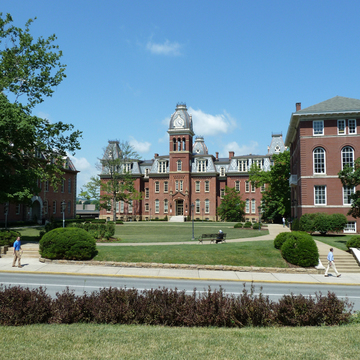West Virginia University, the state's largest institution of higher learning, began as the Agricultural College of West Virginia. It was established in 1867 as a land grant institution under the terms of the 1862 Morrill Act. Morgantown was a leading contender when the state legislature deliberated to choose a site for the school, and when two buildings that formerly housed the Monongalia Academy and Woodburn Seminary, which had merged in 1861, were donated to the new institution, the choice was made. In 1868 the college was renamed West Virginia University.
Soon the university began to expand. The
Post–World War I expansion was accommodated in a handsome group of Georgian Revival buildings designed by Philadelphia architect Paul A. Davis III (1872–1948) of the firm of Davis, Dunlop and Barney. In 1947 the university purchased property along Beechurst Avenue, paralleling the Monongahela River at a level below University Avenue. Here the last of the old campus quadrangles was built. Armstrong Hall (1950), the centerpiece, is flanked on the north by Brooks (1951) and on the south by Hodges Hall (1952). All three buildings have long facades oriented to the river and continue the red-brick-with-limestonetrim motif of the earlier buildings. The Beechurst station of the PRT system ( ML2), which affords convenient access to the Evansdale Campus, now fills the formerly open quad in front of Armstrong Hall. The downtown campus is pedestrian-friendly, and buildings are within easy walking distance of one another. Plaques identify many structures and tell their history.








